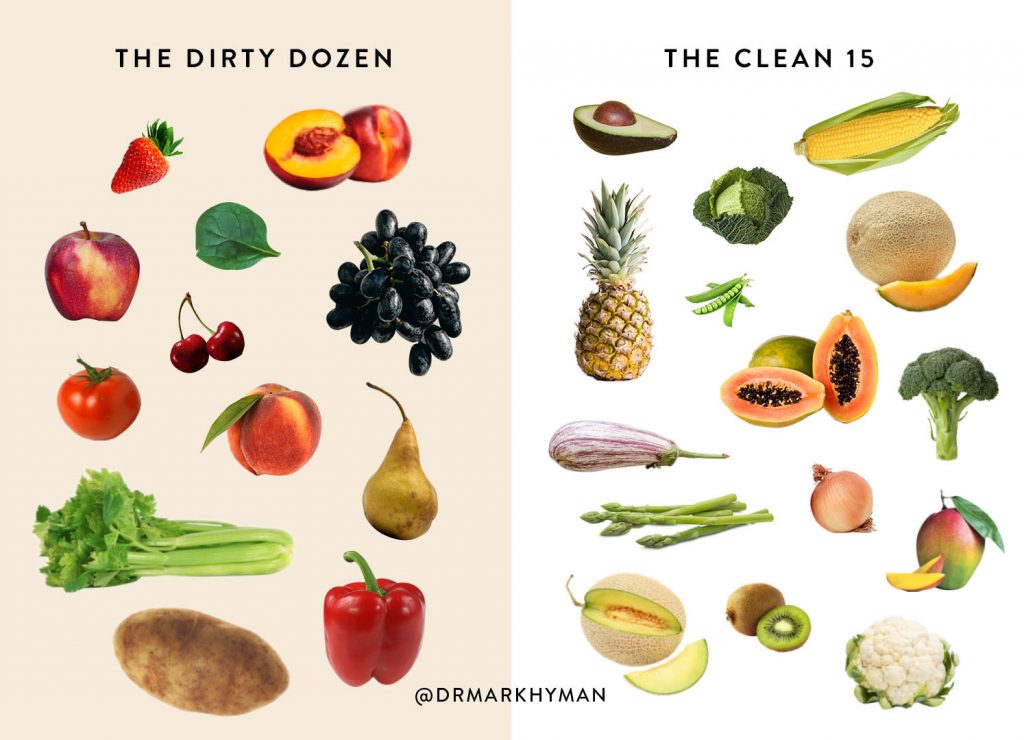Conventional vs. Organic: How to Shop Smarter

When it comes to making the best decision for you and your family, should you buy conventional or organic produce? The answer depends on many factors and it may not be black and white. Where do you live and what do you have access to? What is your food budget? It’s important to understand the difference between conventional and organic produce so that you can make an informed decision.
Conventional produce is grown with agricultural chemicals like herbicides, pesticides, and fungicides. These are used to kill insects and pests that would otherwise threaten the food that farmers are trying to grow and sell. It may sound logical to use these substances to keep pests out, but is it worth the cost? These toxic substances do not magically disappear once they have been sprayed onto the plants. They stick around and contaminate the soil, our water, and eventually our bodies. In fact, studies have shown that these chemicals are found within the umbilical cords of newborns which can impact the health of the infant. These chemicals have also been linked to certain cancers and brain/nervous system damage, increased body mass index (BMI) in children, insulin resistance in rodents, and research has even shown an increased risk for developing Parkinson’s disease from chronic exposure to some pesticides.
On the other hand, organic farmers use pest management techniques that include non-toxic substances to deter insects and pests. They also use alternative strategies such as introducing beneficial insects that keep harmful insects out, fabric covers, sticky traps, and hot pepper mixes. A study done through RMIT University in Australia showed that just one week of eating an organic diet decreased urinary pesticide levels by 90% in adults.
This is promising and it is one way that we can decrease our chemical exposure and overall toxic burden. However, if you’ve done any shopping recently, you have no doubt noticed that organic is pricier than conventional. It would be wonderful to be able to get all of our produce local and organic, but that is not realistic for many. So, what should we do to protect ourselves while not stressing about the cost? The Environmental Working Group’s (EWG) has set out to answer that very question.
It’s important to remember that plant-based foods, especially fruits and vegetables, are the foundation of an optimal diet. If you have to choose between conventional produce or no produce at all, choose conventional. You still get vitamins, minerals, fiber, phytochemicals, and many more beneficial compounds. However, to decrease your toxic burden while not going beyond your budget, I recommend you shop according to the EWG’s Dirty Dozen and Clean Fifteen lists. These are fruits and vegetables that contain the most and least pesticide residues, respectively. This can help you and your family avoid consuming large amounts of these chemicals while also being conscious of the money you spend.
The EWG updates their list every year to reflect the most recent information on pesticide use. They create the list based on USDA test data and take the form in which a food is eaten into consideration. For example, strawberries and blueberries are eaten with the skin, whereas bananas and avocados are peeled. Produce that has a thicker outer skin typically has less pesticide residue. According to the EWG, testing in California showed that nearly 300 pounds of pesticides were used for every 1 acre of strawberries grown. This is why strawberries are at the top of the list. See below for the full list and hold onto the links so you can go back and check each year for the updated lists.
- Strawberries
- Spinach
- Nectarines
- Apples
- Grapes
- Peaches
- Cherries
- Pears
- Tomatoes
- Celery
- Potatoes
- Sweet bell and hot peppers
- Avocado
- *Sweet corn
- Pineapples
- Cabbages
- Onions
- Frozen sweet peas
- *Papaya
- Asparagus
- Mangos
- Eggplant
- Honeydew melon
- Kiwi
- Cantaloupe
- Cauliflower
- Broccoli
*A portion of corn and papaya are grown from genetically modified seeds. If you want to avoid genetically modified produce, it is best to purchase these organic as well.
All hope is not lost when it comes to eating well, avoiding an overload of agricultural chemicals, and taking care of your bank account at the same time. Print out these handy lists from the EWG and take them to the market for an easy way to shop smarter.

